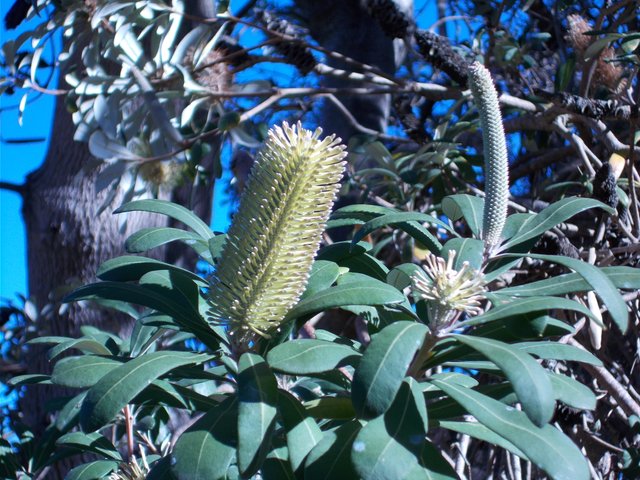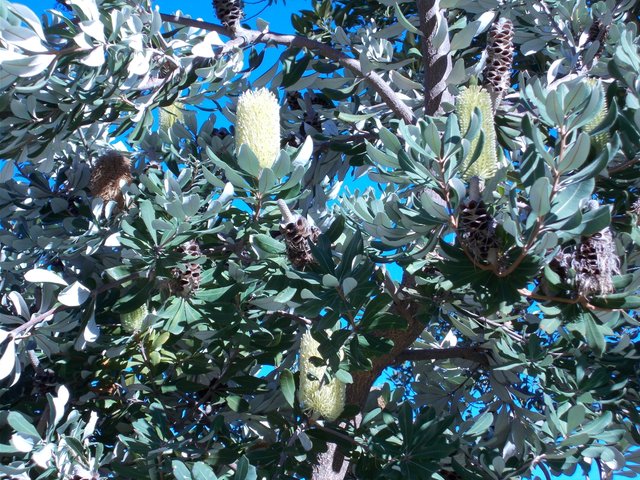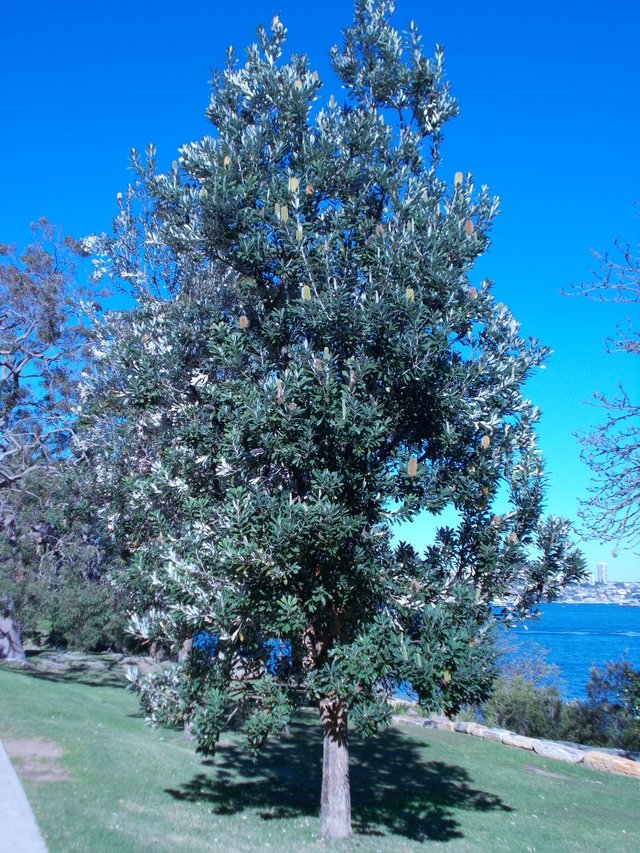Banksia - an iconic Australian Plant.
The Banksia is a plant that most Australians are familiar with. There are story books written about Banksias by an Author and Artist named May Gibbs, with characters like Snugglepot and Cuddlepie and the big bad Banksia men. I used to read this book when i was a young. May Gibbs' house ( Nutcote ) is situated in the North Sydney area, and now she has passed away, it is a heritage listed education centre and museum dedicated to her work.
Banksias are a group of plants containing many species. They range from 15 metre trees to short shrubs or groundcover varieties, and there is one for most garden situations. Some will tolerate boggy or swamp like conditions, and others prefer rocky well drained soil on the sides of cliffs or on the coast where they endure salt spray. The one thing Banksias have in common is the shape of the flowers.... they have a distinctive candle - like shape, and the colours can vary from creamy white to reds and orange and yellow tones. Banksias are sometimes called Australian Honeysuckles, because the flowers produce an abundance of nectar that the birds- especially native Parrots- love.
Some common species of Banksia around Sydney are Banksia intergifolia, and Banksia ( Coast Banksia ) and Banksia serrata ( Old Man Banksia ). Plant breeders have released lots of really nice small growing varieties of the plant which are available in nurseries and garden centres.
I photographed these Banksias in a Sydney waterfront reserve.



Banksia plants belong to a genus of around 170 species native to Australia. They also belong to the Proteaceae plant family, which is an ancient family of flowering plants that dispersed and diversified throughout Gondwana before the supercontinent disintegrated.
With about 1600 species, Proteaceae is one of the plant groups that dominate the southern hemisphere flora. Banksia plants take many forms, from trees up to 30 meters tall, to woody shrubs, to a few prostrate species.
The leaves vary greatly between species, with sizes varying from 1.0–1.5 centimeters long up to 45cm long. The young leaves are velvety and often brownish or yellow in color, while the mature leaves are green or dark green, hard to touch and most species have serrated edges.
Leaves are usually arranged along the branches in irregular spirals, but in some species, they are crowded together in whorls. The most distinguishing feature of banksias is the flower spike, which is an elongated inflorescence consisting of a woody axis covered in tightly-packed pairs of flowers attached at right angles.
A single flower spike generally contains hundreds or even thousands of flowers; the most recorded is around 6000 inflorescences in Banksia grandis.
Source
Fav.comment Award !! Well done, you chose great Pics and included nice information too.
Australia, an island continent isolated by oceans from the rest of the world, has stunning biodiversity of plants. In 1770, Captain Cook and Sir Joseph Banks, his botanist on board the Endeavor, were the first white men to land at "Botany Bay" (Cook's name), and discovered a plant with spikes of golden flowers appearing like ripe ears of corn or bronzed pinecones. Cook, a master navigator and labeler of newly discovered lands and seas, named Banksia after the 26-year-old botanist.
The flower spikes of Banksias are terminal and consist of thousands of individual flowers in pairs around a central woody cone. The brilliant golden-orange styles of River Banksia flare out with soft curved hooks from the woody axis. Sunbirds, with long beaks, can sip out the rich nectar contained deep within them. Old cones from years past perch on the branches, and the winged seeds embedded in the ovaries can remain on the cone indefinitely until the heat of a wildfire forces them open.
Along the southwestern and southeastern coastal areas of Australia are close to 76 species of Banksia with a great variety of leaves and growth habits. From prostrate ground growers, to shrubs, to trees with irregular trunks, Banksia are quite differentiated. A few species are also found in southern New Guinea. River Banksia is a small tree with long slender serrated leaves with pale undersides. The flowers are a magnificent red-gold.
https://www.sfbotanicalgarden.org/garden/bloom_10_02.shtml
Fav. comment Award !! Great Pics and Information. Thanks.
Thank you so much dear @ctrl-alt-nwo
Banksias have special roots called proteoid roots which help them to grow in our low nutrient Australian soils. As such they require little fertilising and are particularly sensitive to high levels of phosphorous, especially when they are young. Once or twice a year apply a certified organic fertiliser which is labeled safe for natives or has a phosphorus content less than 2%.
There are more than 170 species of banksias with all but one being endemic to Australia and they range from ground covers to tall trees. Flowers are yellow, orange, pink and red and many have beautiful serrated leaves.
Probably the most common species grown in the home garden are Banksia spinulosa, Banksia speciosa and Banksia ericifolia while the cultivars ‘Giant Candles’ and ‘Birthday Candles’ are also popular with their prolific flowering.
Generally banksias require little pruning. Simply trim off any dead branches which may appear and prune back to restrict the size/shape if needed.
Source
Silly Sausage Award !! Great Pics and information, thanks.
Source
Banksias are named in honour of botanist Sir Joseph Banks and are popular Australian natives due to their impressive flower spikes consisting of hundreds of smaller flowers.
The nectar laden flowers are perfect for attracting bees and birds into your garden plus they also make great cut flowers indoors where they’ll release their honey scent.
Source
There are more than 170 species of banksias with all but one being endemic to Australia and they range from ground covers to tall trees. Flowers are yellow, orange, pink and red and many have beautiful serrated leaves.
Source
Probably the most common species grown in the home garden are Banksia spinulosa, Banksia speciosa and Banksia ericifolia while the cultivars ‘Giant Candles’ and ‘Birthday Candles’ are also popular with their prolific flowering.
Source
Source
Text Source
The flower heads are made up of hundreds (sometimes thousands) of tiny individual flowers grouped together in pairs. The colour of the flower heads usually ranges from yellow to red. Many species flower over autumn and winter.
The fruits of banksias (called follicles) are hard and woody and are often grouped together to resemble cones (which they are not true cones are produced only by conifers).
The fruits protect the seeds from foraging animals and from fire. In many species the fruits will not open until they have been burnt or completely dried out.
South western Australia contains the greatest diversity of banksias, with 60 species recorded. They are also an important part of the flora of Australia's eastern coast. Few banksias are found in the arid regions of Australia or in the rainforests of the eastern coast.
There are no species which are common to eastern and western Australia except Tropical Banksia, Banksia dentata , which occurs across northern Australia, in Papua New Guinea, Irian Jaya and the Aru Islands.
Source: https://www.anbg.gov.au/banksia/
Banksia is a member of the protea (Proteaceae) family and is a genus of around 75 species of evergreen shrubs and trees that feature attractive foliage, bold flowering spikes, and interesting fruiting cones. These woody low-growing shrubs to low-branching trees are endemic to Australia, with just one species, Banksia dentata, extending from northern Australia to New Guinea. The genus is named for Sir Joseph Banks (17431820), the renowned English botanist who first documented the plants on his travels around Australia with Captain Cook, and who was one of the founders of the Royal Horticultural Society.
Banksias vary from prostrate shrubs to low-branching trees. They are sturdy plants, often with a stout trunk. Typically they have long, leathery, coarsely toothed leaves, though a few species have finer or more needle-like foliage. Cylindrical or globular spikes are densely packed with hundreds of small flowers. The individual thread-like blooms are long lasting and nectar-rich. As the flowers die they develop into large, woody, fruiting cones. Flowering time varies, depending on the species.
http://www.abc.net.au/gardening/plant-finder/banksia/9441934
To improve soils to banksia-friendly condition, add gypsum or other soil conditioner or raise the soil level into a mound at least 30-60 cm above the pre-existing level. Banksias appreciate extra water during dry periods, especially during summer. Special care should be taken not to let them dry out until established. They will eventually put roots deep into the ground and find the water table, but the process may take up to two years.
Fertilising with phosphorus should be minimal. A slow-release, low-phosphorous treatment is best. If new leaves turn yellow use iron chelate or iron sulphate according to the instructions. Species that grow from lignotubers, a group that includes Banksia robur, B. spinulosa and B. serrata, may be pruned hard - even back to ground level. Others, including B. ericifolia and B. ‘Giant Candles’ are nonlignotuberous and should be pruned lightly (not below green foliage) after each flush of flowers. This prolongs the life of the plants and keeps them compact.
https://www.gardenclinic.com.au/how-to-grow-article/banksia?pid=44203
Banksias are named in honour of botanist Sir Joseph Banks and are popular Australian natives due to their impressive flower spikes consisting of hundreds of smaller flowers. The nectar laden flowers are perfect for attracting bees and birds into your garden plus they also make great cut flowers indoors where they’ll release their honey scent.
Banksias also produce very distinctive woody seed pods which you’ll instantly recognise as the big bad Banksia men if you’ve read the children’s book “Snugglepot & Cuddlepie” by May Gibbs.
There are more than 170 species of banksias with all but one being endemic to Australia and they range from ground covers to tall trees. Flowers are yellow, orange, pink and red and many have beautiful serrated leaves.
Source
@ctrl-alt-nwo,
Wow this is the first time I heard about the name of this plant, but probably I saw this plant in Animal Planet or other nature TV series before! But this is the very first time I could know more about this plant! Really appreciate your information and nice photography as well!
Cheers~